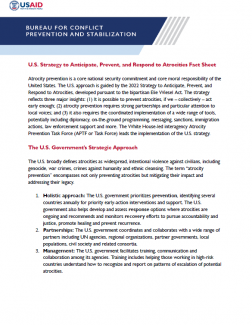Atrocity prevention is a core national security commitment and core moral responsibility of the United States. The U.S. approach is guided by the 2022 Strategy to Anticipate, Prevent, and Respond to Atrocities, developed pursuant to the bipartisan Elie Wiesel Act. The strategy reflects three major insights: (1) It is possible to prevent atrocities, if we – collectively – act early enough; (2) atrocity prevention requires strong partnerships and particular attention to local voices; and (3) it also requires the coordinated implementation of a wide range of tools, potentially including diplomacy, on-the-ground programming, messaging, sanctions, immigration actions, law enforcement support and more. The White House-led interagency Atrocity Prevention Task Force (APTF or Task Force) leads the implementation of the U.S. strategy.
The U.S. Government’s Strategic Approach
The U.S. broadly defines atrocities as widespread, intentional violence against civilians, including genocide, war crimes, crimes against humanity and ethnic cleansing. The term “atrocity prevention” encompasses not only preventing atrocities but mitigating their impact and addressing their legacy.
- Holistic approach: The U.S. government prioritizes prevention, identifying several countries annually for priority early-action interventions and support. The U.S. government also helps develop and assess response options where atrocities are ongoing and recommends and monitors recovery efforts to pursue accountability and justice, promote healing and prevent recurrence.
- Partnerships: The U.S. government coordinates and collaborates with a wide range of partners including UN agencies, regional organizations, partner governments, local populations, civil society and related consortia.
- Management: The U.S. government facilitates training, communication and collaboration among its agencies. Training includes helping those working in high-risk countries understand how to recognize and report on patterns of escalation of potential atrocities.
Advancing the Strategy at USAID
USAID understands that atrocities are predictable and therefore preventable. We also understand that atrocities are antithetical to development, and thus, atrocity prevention is an important part of the work we do. USAID implements programs across the atrocity prevention cycle, building on our long-term presence and partnerships in the countries where we work. We are particularly well-suited to address the underlying risk factors that may lead to atrocities, including insecurity, mass displacement, violent conflict, weak governance, corruption, hate speech and disinformation, and lack of respect for rule of law and human rights. The earlier we work to reduce the atrocity risk, the more likely we are to be successful.
USAID’s atrocity prevention work is diverse, with examples from around the world spanning every phase of atrocity risks. For instance, conflict over land and water is often a significant driver of atrocities, with tensions manifesting along ethnic and religious lines. To address this risk, USAID has assisted communities to develop better conflict mitigation and resource-sharing practices, while enabling people-to-people reconciliation. In other prevention efforts, USAID helped its partners to counter systematic, long-term discrimination against religious and ethnic minority groups through governance and policy interventions, and through more equitable service delivery (legal, health, etc.) across communities. Through its response efforts, USAID has worked in contexts like Ukraine, Ethiopia, Burma, Sudan, and others to support human rights documentation, advance local advocacy efforts, provide legal assistance, and elevate local peacebuilders. Finally, in recovery environments, USAID helps societies address the devastating legacy of atrocities through justice and accountability, reconciliation, and government reform, while elevating collective respect for human rights and peace.

